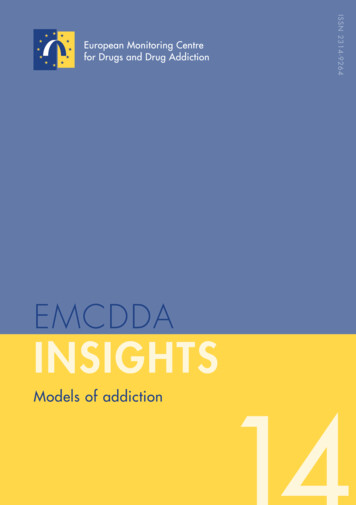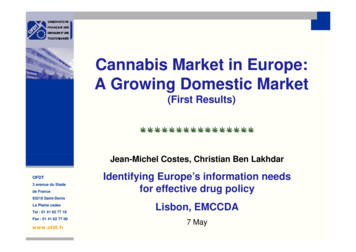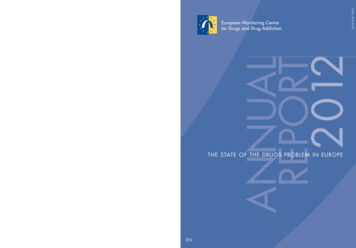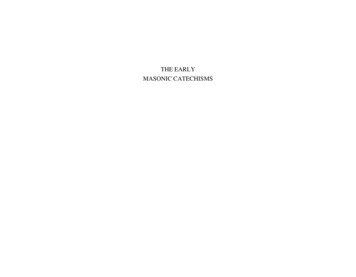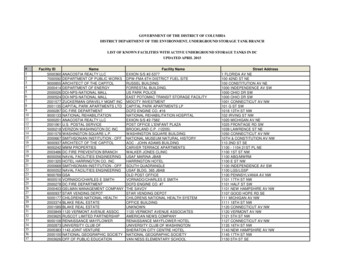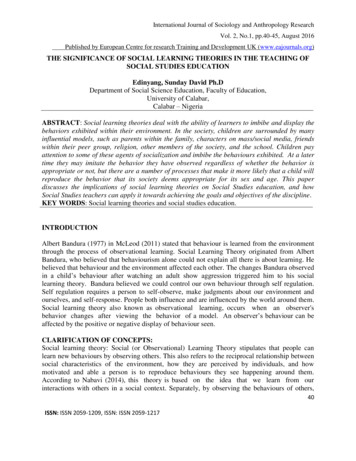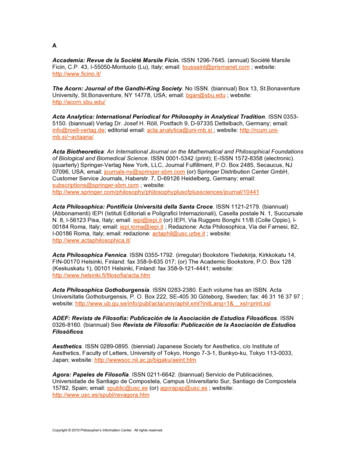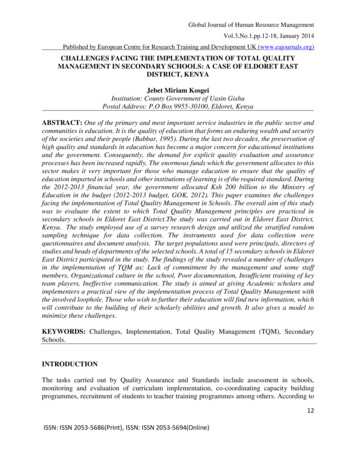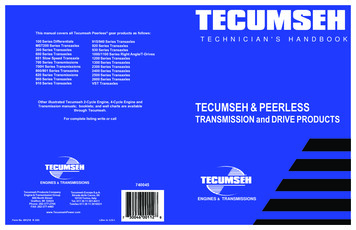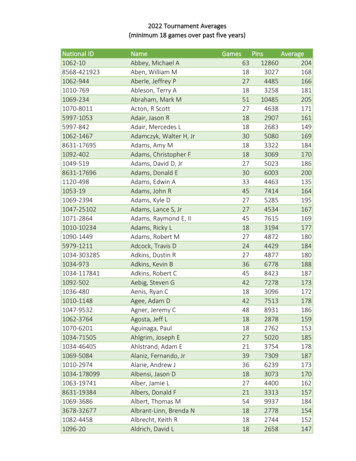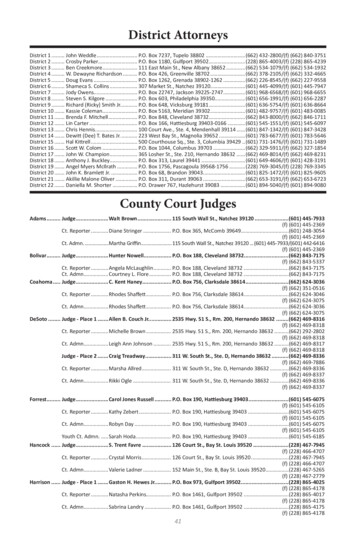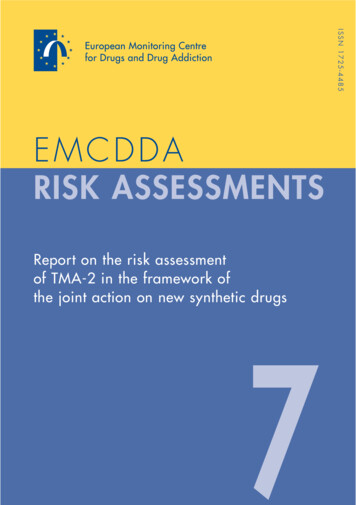
Transcription
ISSN 1725-4485EMCDDARISK ASSESSMENTSReport on the risk assessmentof TMA-2 in the framework ofthe joint action on new synthetic drugs7
European Monitoring Centrefor Drugs and Drug AddictionReport on the risk assessmentof TMA-2 in the framework ofthe joint action on new synthetic drugs
Information on the EMCDDA can be found on its website (http://www.emcdda.eu.int).A great deal of additional information on the European Union is available on the Internet.It can be accessed through the Europa server (http://europa.eu.int).Cataloguing data can be found at the end of this publication.Luxembourg: Office for Official Publications of the European Communities, 2004.ISBN: 92-9168-182-2 European Monitoring Centre for Drugs and Drug Addiction, 2004.Reproduction is authorised provided the source is acknowledged.Printed in BelgiumEuropean Monitoring Centrefor Drugs and Drug AddictionRua da Cruz de Santa Apolónia 23-25, P-1149-045 LisbonTel. (351) 218 11 30 00 Fax (351) 218 13 17 11info@emcdda.eu.int http://www.emcdda.eu.int
il decision15Chapter 1: Report on the risk assessment of TMA-2in the framework of the joint actionon new synthetic drugs19Chapter 2: Europol–EMCDDA progress reporton TMA-233Chapter 3: Review of the pharmacotoxicological dataon TMA-239Chapter 4: Sociological and criminological evidence andpublic health risks53References59Participants in the risk assessment process65Text of the 1997 joint action69
4
ForewordForewordIt gives me particular pleasure to present the results of the risk assessmentundertaken by the European Monitoring Centre for Drugs and Drug Addiction(EMCDDA) on the substance TMA-2 (2,4,5-trimethoxyamphetamine) in thispublication. The risk assessment was carried out under the terms of a joint actionadopted on 16 June 1997 by the Council of the European Union (1).The meeting to assess the risks of TMA-2 was convened under the auspices of theScientific Committee of the EMCDDA and was held on 1 April 2003 at theCentre’s headquarters in Lisbon. The meeting produced a formal ‘Report on therisk assessment of TMA-2 in the framework of the joint action on new syntheticdrugs’, which was adopted the same day. As foreseen in the joint action, thereport was submitted without delay to the European Commission and to the GreekPresidency of the Horizontal Working Party on Drugs of the Council of the EU forfurther action.As a result, on 27 November 2003, the Council adopted the decision (2) to submitto control measures and criminal penalties in the 15 EU countries. The Councildecision stipulates that, within three months, Member States shall introduce thenecessary measures into their national law, in compliance with their obligationsunder the 1971 United Nations (UN) Convention on Psychotropic Substances.Such a concrete result at a political level confirms the effectiveness of the rapidresponse mechanism provided by the joint action on new synthetic drugs. It is alsoencouraging to see that strong cooperation has developed over recent yearsbetween the EMCDDA and its institutional partners involved in the risk assessmentprocess, including the European Police Office (Europol), the European Agency forthe Evaluation of Medicinal Products (EMEA) and the European Commission. Inparticular, I would like to underline the excellent work done by the EMCDDA’searly-warning system via the Reitox network of national focal points and throughEuropol’s national units. The dedication of all partners will be crucial in thesuccessful implementation of the new Council decision proposed by the(1) Joint action concerning the ‘information exchange, risk assessment and the control of new synthetic drugs’ (OJ L 167,25.6.1997). A joint action is a decision adopted unanimously by the EU Member States within the framework of thethird pillar of the Treaty on European Union (cooperation in the field of justice and home affairs). Synthetic drugs arepsychoactive substances produced in laboratories and not derived from natural products. They include 3,4methylenedioxy-N-methylamphetamine (MDMA, ‘ecstasy’), other amphetamines and lysergic acid diethylamide (LSD).(2) OJ L 321, 6.12.2003, pp. 64–65.5
Report on the risk assessment of TMA-2 in the framework of the joint action on new synthetic drugsCommission to replace the 1997 joint action on new synthetic drugs. This initiativeis directly related to the outcome of the external evaluation of the joint actionundertaken by the Commission as stipulated by the European Union action plan ondrugs 2000–04. The new legal instrument aims to clarify the definitions andprocedures and extend the scope to all new synthetic drugs and new narcoticdrugs alike.I would like to thank all those who participated in the risk assessment process forTMA-2 for the high quality of the work carried out. This makes a valuablescientific contribution, validated at a European level, and, as such, gives provensupport to political decision-making.Georges EstievenartExecutive Director, EMCDDA6
5-dimethoxy-4-(n)-propylthiophenethylaminebpmbeats per coGelectrocorticography5-HT5-hydroxytryptamine .intravenousLD50lethal dose for 50 % of animals testedLSDlysergic acid diethylamideMAOmonoamine oxidaseMAOImonoamine oxidase ethoxymethylamphetamineSSRIselective serotonin reuptake trimethoxyamphetamine9
IntroductionIntroductionSince the adoption by the Council in June 1997 of the joint action on theinformation exchange, risk assessment and control of new synthetic drugs, TMA-2(2,4,5-trimethoxyamphetamine) is the ninth substance to be subjected to riskassessment.Synthesised in 1947, TMA-2 is one of the numerous ‘new synthetic drugs’ with nolegitimate therapeutic use that are described in Shulgin’s Pikhal (Shulgin andShulgin, 1991). TMA-2 can be produced from the active agent asarone (2,4,5trimethoxyphenyl-1-propenylbenzene), which is extracted from the rhizome of theplant Acorus calamus. The precursor asarone (2,4,5-trimethoxyphenyl-1propenylbenzene) is widely used as an active principle in food flavourings. TMA-2has the structural characteristics of amphetamines, which are associated withhallucinogenic and stimulant actions. It is an analogue that is very close to TMA(3,4,5-trimethoxyamphetamine) but is 10 times more potent (20 mg of TMA-2induces the same hallucinogenic effects as 200 mg of TMA). Therefore it carriespotential risks common to TMA and other hallucinogenic substances (e.g. DOM,DOB) already classified in Schedule I of the 1971 United Nations Convention onPsychotropic Substances.The specific scientific risk assessment of TMA-2 has been extremely difficult, due tothe lack of peer-reviewed scientific data. There are, however, some limited datafrom studies carried out in the 1970s and 1980s. An overview of thepharmacology, toxicology, clinical experience and individual health andpsychological risks of TMA-2 use was compiled by Michel Mallaret of the Centred’évaluation et d’information sur la pharmacodépendance, Centre hospitalieruniversitaire, Grenoble. Moreover, Mallaret performed an original study on thetoxic effects of TMA-2 in rats. This overview was further extended by a review,completed by the EMCDDA and Europol, of the pharmacotoxicological,sociological and criminological information available on TMA-2. Informationbased on analogy to related compounds, such as TMA, was also utilised for thisassessment.The members of the Scientific Committee of the EMCDDA, extended with expertsnominated by the Member States and representatives of the European Commission,11
Report on the risk assessment of TMA-2 in the framework of the joint action on new synthetic drugsEuropol and the EMEA, met in Lisbon on 1 April 2003 to examine the health andsocial risks of TMA-2, as well as the possible consequences of its prohibition. Theconclusions and recommendations of the risk assessment report were preparedand adopted the same day. Based on the conclusions of the report, the Councilunanimously decided to adopt a decision making TMA-2 the subject of controlmeasures in the EU Member States, as provided for under Schedules I and II of the1971 UN Convention on Psychotropic Substances.In the light of the risk assessments carried out since 1998, the ScientificCommittee’s sub-committee on synthetic drugs came to the following conclusions:the decision to have a molecule assessed often implies a lack of scientific dataabout its toxicity as well as its dependence potential or its implication in socialdisturbances; however, lack of scientific data does not guarantee that the moleculeis not harmful. A principle of precaution should therefore be the rule when onlylimited data are available.The Scientific Committee of the EMCDDA is aware of how difficult it is to obtainscientific data on a new drug and is currently reflecting, in the framework of itssub-committee on synthetic drugs, on the possibility of proposing an emergencytemporary scheduling of the identified substance in order to allow time forcollecting and producing sufficient scientific information. However, such a proposalcould only be discussed within the perspective of a new Council decisionmodifying the current joint action on new synthetic drugs. Meanwhile, despite itslimitations, the provisions of Article 4 of the joint action have been implementedfor the risk assessment of TMA-2.As Chairperson and Vice-Chairperson of the Scientific Committee, we would liketo express our gratitude to our colleagues on the Scientific Committee as well as tothe staff of the EMCDDA, in particular Alain Wallon, Lena Westberg, DeborahOlszewski and Roumen Sedefov, who worked hard before, during and after themeetings to finalise the reports in order to provide detailed and preciseconclusions and ensure a speedy completion of the project. We hope that all theseefforts will be appreciated by those to whom this report is addressed.Salme Ahlström and Jean-Pol TassinChairperson and Vice-Chairperson, Scientific Committee of the EMCDDA12
Council decisionCouncil decisionCouncil Decision 2003/847/JHA of 27 November 2003 concerningcontrol measures and criminal sanctions in respect of the new syntheticdrugs 2C-I, 2C-T-2, 2C-T-7 and TMA-2THE COUNCIL OF THE EUROPEAN UNION,Having regard to the Treaty on European Union,Having regard to Council Joint Action 97/396/JHA of 16 June 1997 concerningthe information exchange, risk assessment and the control of new synthetic drugs(3), and in particular Article 5(1) thereof,Having regard to the initiative of the Italian Republic,Whereas:(1) Risk assessment reports on 2C-I (2,5-dimethoxy-4-iodophenethylamine), 2C-T-2(2,5-dimethoxy-4-ethylthiophenethylamine), 2C-T-7 (2,5-dimethoxy-4-(n)propylthiophenethylamine), TMA-2 (2,4,5-trimethoxyamphetamine) were drawnup on the basis of Article 4(3) of Joint Action 97/396/JHA at a meetingconvened under the auspices of the Scientific Committee of the EuropeanMonitoring Centre for Drugs and Drug Addiction.(2) 2C-I, 2C-T-2, 2C-T-7 and TMA-2 are amphetamine derivatives havingstructural features of phenethylamines, which are associated withhallucinogenic and stimulant activity. 2C-I, 2C-T-2, 2C-T-7 and TMA-2 have notbeen reported to be associated with fatal or non-fatal intoxication within theCommunity. However, 2C-I, 2C-T-2, 2C-T-7 and TMA-2 are hallucinogenicdrugs that carry potential risks common to other hallucinogenic substancessuch as 2C-B, DOB, TMA and DOM, already classified in Schedules I or II tothe 1971 United Nations Convention on Psychotropic Substances. Therefore arisk of acute or chronic toxicity cannot be excluded.(3) 2C-I, 2C-T-2, 2C-T-7 and TMA-2 are not currently listed in any of theSchedules to the 1971 United Nations Convention on Psychotropic Substances.(3) OJ L 167, 25.6.1997, p. 1.15
Report on the risk assessment of TMA-2 in the framework of the joint action on new synthetic drugs(4) At present, 2C-I and 2C-T-2 are controlled under the national drugs legislationin five Member States; 2C-T-7 and TMA-2 are controlled in four MemberStates.(5) 2C-I, 2C-T-2, 2C-T-7 and TMA-2 have no therapeutic value or industrial use.(6) 2C-I has been identified in four Member States; 2C-T-2 and 2C-T-7 have beenidentified in six Member States; TMA-2 has been identified in five MemberStates. At present one Member State has reported one case of internationaltrafficking of 2C-T-2 involving two Member States; no international traffickingof 2C-I, 2C-T-7 and TMA-2 has been reported. Laboratories involving theproduction of 2C-I, 2C-T-2, 2C-T-7 and TMA-2 have been seized in threeMember States. In one of these Member States, the seizure of a large amountof the intermediate precursor 2C-H and documentation suggests the productionof 2C-I. The major chemical precursors of 2C-I, 2C-T-2, 2C-T-7 and TMA-2 arecommercially available.(7) 2C-I, 2C-T-2, 2C-T-7 and TMA-2 should be subjected by the Member States tocontrol measures and criminal penalties, as provided for under their legislationcomplying with their obligations under the 1971 United Nations Convention onPsychotropic Substances with respect to substances listed in Schedules I or IIthereto,HAS DECIDED AS FOLLOWS:Article 1Member States shall take the necessary measures, in accordance with theirnational law, to submit 2C-I (2,5-dimethoxy-4-iodophenethylamine), 2C-T-2 (2,5dimethoxy-4-ethylthiophenethylamine), 2C-T-7 (2,5-dimethoxy-4(n)-propylthiophenethylamine) and TMA-2 (2,4,5-trimethoxyamphetamine) tocontrol measures and criminal penalties, as provided for under their legislationcomplying with their obligations under the 1971 United Nations Convention onPsychotropic Substances with respect to substances listed in Schedules I or IIthereto.Article 2Member States shall, in accordance with the third subparagraph of Article 5(1) ofJoint Action 97/396/JHA, take the measures referred to in Article 1 within three16
Council decisionmonths of the date on which this Decision takes effect.Within six months of the date on which this Decision takes effect Member Statesshall inform the General Secretariat of the Council and the Commission of themeasures they have taken.Article 3This decision shall be published in the Official Journal of the European Union.It shall take effect on the day following that of its publication.Done at Brussels, 27 November 2003.For the CouncilThe PresidentR. Castelli17
Chapter 1Chapter 1Report on the risk assessment of TMA-2 in theframework of the joint action on new syntheticdrugsOn 12 December 2002, the Horizontal Working Party on Drugs (HWPD) of theCouncil of the European Union decided that risk assessment of four new syntheticdrugs, 2C-T-2, 2C-T-7, 2C-I and TMA-2, should be initiated. On 20 December 2002,in accordance with practice under the 1997 joint action, the Danish Presidencyformally notified the EMCDDA of the HWPD’s decision to submit 2C-T-2, 2C-T-7, 2C-Iand TMA-2 for risk assessment under Article 4 of the joint action on new syntheticdrugs of 16 June 1997.A meeting of the Scientific Committee of the EMCDDA, extended with expertsnominated by the Member States and representatives of the European Commission,Europol and the EMEA, was held on 1 April 2003 to assess the health and socialrisks of TMA-2 as well as the possible consequences of its prohibition.The meeting considered the following documents:Review of the pharmacotoxicological data for the risk assessment of TMA-2;report to the EMCDDA(ii) Public health risks: epidemiological evidence; EMCDDA(iii) Sociological/criminological evidence; EMCDDA(iv) Europol contribution to the risk assessment on TMA-2(i)In conjunction with further information and comments from the expert participants,these documents formed the basis of the risk assessment which is reported below.Chemical descriptionTMA-2 is 2,4,5-trimethoxyamphetamine. According to the synthesis protocoldescribed by Shulgin and Shulgin (1991), the main precursor in the synthesis of TMA2 is 2,4,5-trimethoxybenzaldehyde, which is available commercially. Additional19
Report on the risk assessment of TMA-2 in the framework of the joint action on new synthetic drugssubstances needed for the synthesis are: nitroethane, anhydrous ammonium acetate,MeOH. The intermediate substance is 2-nitro-1-(2,4,5-trimethoxyphenyl) propene(yellow crystals). An oily precipitate is washed and dried to produce 2,4,5trimethoxyamphetamine (TMA-2) hydrochloride in the form of white crystals.TMA-2 is a synthetic drug that can also be produced from the active agent asarone(2,4,5-trimethoxyphenyl-1-propenylbenzene), which is extracted from the rhizome ofthe plant Acorus calamus, the common sweet flag, which grows wild on the edges ofswamps throughout America, Europe and Asia. To obtain 36.5 g of TMA-2 requires10 kg of Acorus calamus. Recipes for extracting asarone and making TMA-2 areavailable on the Internet, together with warnings about contraindications.The precursor asarone (2,4,5-trimethoxyphenyl-1-propenylbenzene) (4) is widely usedas an active agent in food flavourings. However, the United States Food and DrugAdministration (FDA) considers Acorus calamus to be an ‘unsafe herb’, due to itscarcinogenicity, nephrotoxicity and neurotoxicity, and its use in food is limited to amaximum concentration of 0.1 mg/kg. The Council of Europe’s Committee of Expertson Flavouring Substances (CEFS) has proposed reducing this to 0.05 mg/kg for foodand beverages sold in Europe (5).At present, TMA-2 has no medical or industrial use.Pharmaceutical descriptionTMA-2 is available in powder form, or as a red capsule (in France) or an orangecapsule (in Spain). In France, there have been instances of TMA-2 being sold underthe name ‘TMA-2’; in other cases, the name was unknown. In the Netherlands, theAmsterdam Antennae project monitored TMA-2 under the name ‘Zerox’, but users didnot use this name.(4) There are different asarones, with alpha-asarone being trans-propenyl, beta-asarone the cis-propenyl and gammaasarone (also called euasarone) being the allyl-isomer.(5) The European Commission, Scientific Committee on Food SCF/CS/FLAVOUR/9 ADD1 Final, 8 January 2002.20
Chapter 1There is no direct evidence on the routes of administration used. However, as the drugwas mainly detected in capsules, the main administration route may be oral. Eventhough the drug has also been found in powder form, there are no reports ofintranasal administration or injecting.There are no scientific reports on TMA-2 use in combination with other drugs.However, on one Internet forum a user describes an experience of a ‘phenethylaminebinge’ with 40 mg TMA-2 in combination with 2C-T-2 and 2C-B.Shulgin and Nichols (1978) mention that the effective oral dose of TMA-2 for humansis between 10 and 30 mg. The original study by Shulgin involved oral administrationof 20–40 mg of TMA-2. This compares to Shulgin and Nichols’ recommended‘equipotent’ dose of 30–50 mg for 2,5-DMA, 0.2–1 mg for DOB and 1–5 mg forDOM.Health risksIndividual health risksAcute effectsTMA-2 was studied in the 1970s and 1980s. However, few data are available.TMA-2 is a 5-HT2 receptor agonist. It inhibits the binding of D-LSD in rat brainmembranes. TMA-2 has been shown to have an affinity for rat fundus 5-HT receptorsand for rat cortical brain 5-HT1 and 5-HT2 receptors.There are no data about the neuroendocrinology of TMA-2.The neuro-behavioural effects of TMA-2 in rats have been studied recently (Mallaret etal., 2002). Intraperitoneal (i.p.) administration of TMA-2 in rats induces increasedlocomotor activity, which may be due to a moderate stimulant effect and/or toserotonin-mediated behavioural syndrome. Increased motor activity and behaviouralchanges occur even with low doses of TMA-2 (2 mg/kg). If the dose is increased(2–80 mg/kg), rats present a serotonin-mediated behaviour (head and trunkweaving, forepaw treading, flat body posture with hind limb abduction, salivation,hyperactivity and ‘wet dog shake’, etc.). It may be assumed that TMA-2 induces most21
Report on the risk assessment of TMA-2 in the framework of the joint action on new synthetic drugsof these symptoms. The locomotor increase (which is less significant thanamphetamine-induced hyperactivity) may also be due to 5-HT receptor stimulation.The highest TMA-2 doses (80 mg/kg) induce frequent clonic convulsions. A dose of120 mg/kg was associated with fatal toxic effects (6).In rats, even low i.p. doses of TMA-2 (2 mg/kg) induce a significant bradycardia,especially when the ambient temperature is low (at 18 C, the decrease is from500 bpm to 250 bpm). The intensity of the bradycardia does not vary much with lowor high (80 mg/kg) doses of TMA-2. The arterial (systolic, diastolic and mean) bloodpressure increases as the TMA-2 dose is raised. The mean systolic blood pressuremay reach 165 mm Hg.The amphetamine thermoregulatory response is usually hyperthermia, even if lowdoses of serotonergic agents may induce hypothermia. Whereas, in rats, when theambient temperature is low (18 C), low and high TMA-2 doses (2–80 mg/kg) inducesignificant hypothermia (33 C; compared with 38 C for the saline control group).The hypothermia may be due to dopaminergic D2 receptor activation. It has alsobeen suggested that it may be due to D1 and/or serotonin receptor activation,and/or NMDA activation.There are no data on the pharmacokinetics of TMA-2. However, one study suggeststhat, in rats, TMA-2 is demethylated and metabolised to a hydroquinone.There are few animal and no human data concerning TMA-2 toxicity, reproductivetoxicity, neurotoxicity, mutagenicity and carcinogenic potential.Clinical effectsThere have been no reported deaths or instances of non-fatal intoxication involvingTMA-2.After ingestion of increasing doses of TMA-2, Shulgin described hallucinogeniceffects, with nausea, light tremors and modest eye dilation. He also mentions briefintestinal cramps, some diarrhoea and difficulty sleeping, but no other adverse effects.(6) A study in mice (Ho et al., 1970) estimated the lethal dose of TMA-2 for 50 % of the animals (LD50) as 180 mg/kg.22
Chapter 1DependenceDiscriminative studies in animals have concluded that TMA-2 induces ‘subjective’effects that seem to be different to amphetamine effects. TMA-2 induces similar effectsto those produced by 2,5-dimethoxy-4-methylamphetamine, which only differs on theC 4 by a methyl group instead of a methoxy for TMA-2.There have been no self-administration studies.There are no data about the dependence potential of TMA-2 in humans. The onlyinformation available is a description of subjective ‘potent hallucinogenic effects’ byShulgin and Shulgin (1991).Psychological effectsThere are no published data concerning the specific psychological effects of TMA-2except anecdotal subjective user reports. Shulgin reported experiencing the ‘entirepackage of mescaline’ effects, except the intense colour enhancement (40 mg ofTMA-2).Public health risksAvailability and quality of TMA-2 on the marketTMA-2 has been identified in five EU Member States: Germany, Spain, France, theNetherlands and the UK.Information based on early warning system databases suggests that TMA-2 is veryrare. The Dutch Antennae Project found TMA-2 use in a small network ofexperimenters (‘psychonauts’) and a small group of ‘frontline’ clubbers.In the Netherlands, capsules were sold in a package that also contained an adviceleaflet describing the formula, effects and dangers of TMA-2.There is no reliable information on the price of TMA-2. In France, the price for onecapsule of TMA-2 was EUR 15 in 2002.23
Report on the risk assessment of TMA-2 in the framework of the joint action on new synthetic drugsKnowledge and perception of TMA-2 among usersThe level of awareness of TMA-2 is, in general, negligible, except among smallesoteric subgroups of experimenters. Due to the lack of human research studies, thelevel of knowledge among these particular consumer subgroups (as can be seen onthe Internet) appears to be more detailed than in the general scientific community.However, perceptions among consumers about the content of products sold as TMA-2are usually based on the information provided by suppliers and the beliefs ofconsumers. In the absence of accurate and regulated chemical analysis, objectivescientific knowledge remains extremely limited. Major information sources are Internetsites and ‘dance floor pharmacology’ (an informal network whereby informationpasses from friend to friend).Prevalence and patterns of useScientific evidence of TMA-2 use in the EU is very limited. Population surveys ofyoung adults in the EU show that a range of 1 % in Finland to 12 % in the UK have‘lifetime prevalence’ of hallucinogenic substances, most commonly ‘magic’mushrooms. School surveys of 15- to 16-year-olds in the EU show that 1–5 % of thisage group have used LSD or other hallucinogens, compared to 10 % in the USA(EMCDDA and ESPAD).Characteristics and behaviours of usersAs mentioned above, TMA-2 users may belong to a small group of people with apseudo-scientific interest in experimenting with hallucinogenic substances, oftenreferred to as ‘psychonauts’. There appears to be a trend among a small butsignificant minority of users towards broadening their repertoire of drug experiences,involving a wider range of drugs and combinations. Special concerns relate to thelack of knowledge about the drug contents and the specific harmful effects of TMA-2,either alone or in combination with other drugs.Indicators of health consequencesWith such an apparently small population of users, information on the healthconsequences of TMA-2 use is very limited. There is no information available on thelong-term consequences of TMA-2 use.24
Chapter 1Context of useThere is no scientific evidence about the risk factors linked to the circumstances andconsumption practices associated with TMA-2.Social risksSociological aspectsYoung people outside of the ecstasy-using population are relatively unlikely to comeinto contact with TMA-2 under present conditions.As with all illicit drug use, lack of scientific and objective information contributestowards increased risk. Firstly, inaccurate media coverage and overestimations ofprevalence may promote diffusion by encouraging young people to try it. Secondly,official dissemination of inaccurate information is counterproductive, as it canundermine credibility.A few more experimental drug users appear to be motivated by a desire toexperience a wide range of sensations. It is not known how many there are in thisgroup, but they are not insignificant.Social consequencesThere is currently no scientific evidence of negative social consequences. However,TMA-2 carries potential risks common to other hallucinogenic substances.Consequences for the social behaviour of the userThere is no specific evidence to link the use of TMA-2 to disorderly conduct,acquisitive crime or violence.Other social consequencesThere is no indication that TMA-2 is particularly associated with any major valueconflicts or has any important implications for social institutions beyond thosedescribed for similar compounds.25
Report on the risk assessment of TMA-2 in the framework of the joint action on new synthetic drugsCriminological aspectsThe law enforcement agencies of all 15 Member States reported to Europol that thereis no information available that would suggest large-scale production, distributionand/or trafficking of TMA-2 or that organised crime has a role in these activities.Belgium and Italy reported that the main reason for the lack of information is that thesubstance is not controlled in these countries and, therefore, no records are kept bythe law enforcement agencies.Germany reported to Europol that a limited quantity of TMA-2 was produced in1999. This related to one case only, involving a small ‘kitchen-type’ laboratory inBrannenburg, Bavaria. The amount seized was 4 g.The Reitox national focal points reported to the EMCDDA on four other findings:1.24 g in powder form was seized in the UK from a small laboratory, in April 2001,in what is believed to have been one attempt to manufacture TMA-2 for personal use;Spain reported a case of trafficking, and a seizure of 185 orange capsules, in March2001, near the city of Valencia; in France, two samples of TMA-2 were collectedthrough the Sintes project in August 2002 in the south-west region; in theNetherlands, DIMS has identified TMA-2 on five occasions — two samples in powderform, one sold in July 2001 and the other one in October 2002, monitored by theAmsterdam Antennae Project under the code name ‘Zerox’, and three capsules ofTMA-2 between May and July 2001.The total amount of TMA-2 seized in the Member States is very small when comparedwith the overall ecstasy seizures in the European Union (over 15 million tabletsannually in recent years). Member States law enforcement agencies did not have anydata on violence in connection with the production, distribution and trafficking ofTMA-2.Possible consequences of prohibitionLegal statusTMA-2 is a controlled drug in four EU Member States: Germany, Greece, Ireland andthe UK.26
Chapter 1In the UK, TMA-2 is a controlled Class A drug under the Misuse of Drugs Act 1977and is covered by the generic definition (TMA-2 is a positional isomer of the UNcontrolled drug TMA).In Ireland, arising from a similar generic approach, the drug is classified underSchedule 1 of the Misuse of Drugs Act.In Germany, TMA-2 is controlled under Schedule I (BtMG, September 1999).In Greece, TMA-2 is classifi
Synthesised in 1947, TMA-2 is one of the numerous 'new synthetic drugs' with no legitimate therapeutic use that are described in Shulgin's Pikhal (Shulgin and Shulgin, 1991). TMA-2 can be produced from the active agent asarone (2,4,5-trimethoxyphenyl-1-propenylbenzene), which is extracted from the rhizome of the plant Acorus calamus. The .
